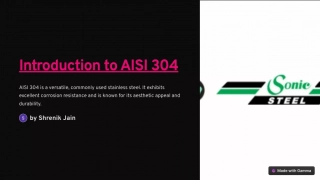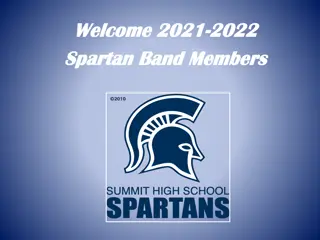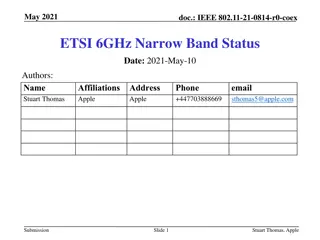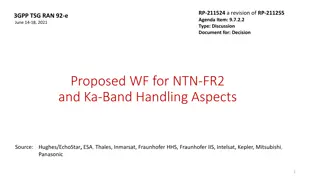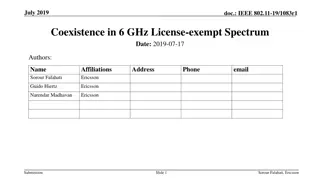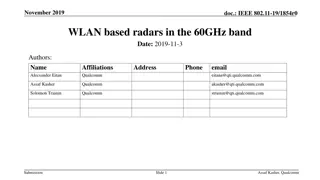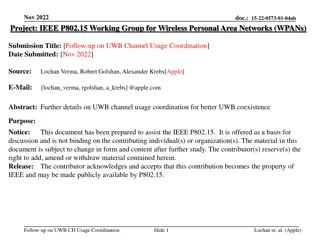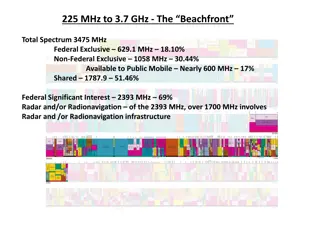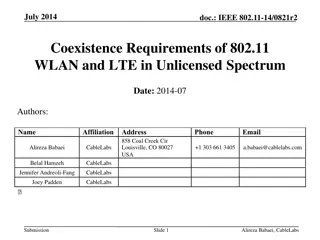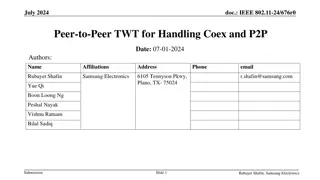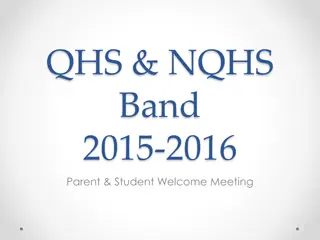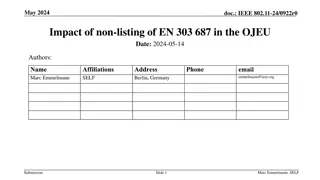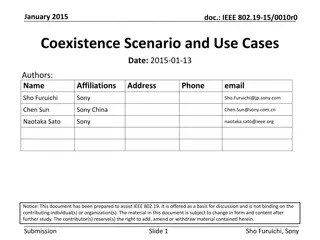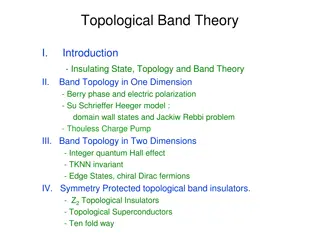
Coexistence Between Radars and Communication Systems in 60GHz Band
Explore the coexistence challenges between radar sensing systems and communication systems in the 60GHz band. Understand the different technologies and access rules while discussing regulatory considerations for diverse uses.
Download Presentation

Please find below an Image/Link to download the presentation.
The content on the website is provided AS IS for your information and personal use only. It may not be sold, licensed, or shared on other websites without obtaining consent from the author. If you encounter any issues during the download, it is possible that the publisher has removed the file from their server.
You are allowed to download the files provided on this website for personal or commercial use, subject to the condition that they are used lawfully. All files are the property of their respective owners.
The content on the website is provided AS IS for your information and personal use only. It may not be sold, licensed, or shared on other websites without obtaining consent from the author.
E N D
Presentation Transcript
May 2021 doc.: IEEE 802.11-21/0796r0 Coexistence between radars and communication systems in the 60GHz band Date: 2019-05-11 Authors: Name Affiliations Address Phone email Alecsander Eitan Qualcomm eitana @qti.qualcomm.com Assaf Kasher Qualcomm akasher @qti.qualcomm.com Bin Tian Qualcomm btian@qti.qualcomm.com Alan Norman Facebook alannorman@fb.com Da Silva, Claudio Intel claudio.da.silva@intel.com Submission Slide 1 Assaf Kasher & Alecsander Eitan, Qualcomm
May 2021 doc.: IEEE 802.11-21/0796r0 Abstract The 60 GHz band is shared by communication systems and radar sensing systems Each of these systems are based on different technology and are subject to different access rules Coexistence among diverse uses is discussed in several regulatory bodies and industry forums Submission Slide 2 Assaf Kasher & Alecsander Eitan, Qualcomm
May 2021 doc.: IEEE 802.11-21/0796r0 Communication usages in the 60 GHz band Gigabit and fast WLAN access (based on IEEE802.11ad & 11ay) Low latency applications like AR/VR (based on IEEE802.11ad & 11ay) Gigabit backhaul, fixed wireless access indoor & outdoor (based on IEEE802.11ay) Legacy mmWave point-to-point link (proprietary PHY & MAC) Other protocols (e.g., Wireless HDMI) and more Note that 11ay&bf can also be used for radar/sensing function. However, from a coexistence point of view, 11ay&bf radar behaves just like a communication 11ad/ay device. Submission Slide 3 Assaf Kasher & Alecsander Eitan, Qualcomm
May 2021 doc.: IEEE 802.11-21/0796r0 Radar usages in the 60 GHz band Broadly speaking, mainly two types of radar: FMCW radar and 11ay/11bf based radar Gesture recognition Room sensing Car in-cabin sensing (left behind child, driver sleepiness detection) Health Application fall detection breathing/pulse tracking Wall Penetrating Radar and more Submission Slide 4 Assaf Kasher & Alecsander Eitan, Qualcomm
May 2021 doc.: IEEE 802.11-21/0796r0 Communication Access WLAN (11 access) LBT (listen before talk) Follow NAV rules preamble detection energy detection TDD access Scheduled Access in service periods Used in narrow beam systems Channelization 11ad/ay can set up BSS in different channels for better coexistence Submission Slide 5 Assaf Kasher & Alecsander Eitan, Qualcomm
May 2021 doc.: IEEE 802.11-21/0796r0 FMCW Radar Access FMCW Radar is based on transmission of sweep CW pulse. One or more pulses form a burst, and bursts are periodically transmitted. Radar parameters: EIRP, sweep BW, sweep/pulse duration, number of pulses in a burst and burst period are derived from the radar requirements (max range, range resolution, max doppler, doppler resolution) and HW limitations. In general, radar transmits periodically based on the parameters. There is no coordination of medium access Due to the nature of FMCW signal, the impact from the collision of two FWCM radar signals is limited. Submission Slide 6 Assaf Kasher & Alecsander Eitan, Qualcomm
May 2021 doc.: IEEE 802.11-21/0796r0 Examples of FMCW Radar Pattern Cycle Burst Burst Single Burst per Cycle FH FL Sweep Pulse Cycle . Set of Bursts Set of Bursts Multiple Bursts perCycle Burst Submission Slide 7 Assaf Kasher & Alecsander Eitan, Qualcomm
May 2021 doc.: IEEE 802.11-21/0796r0 Submission Slide 8 Assaf Kasher & Alecsander Eitan, Qualcomm
May 2021 doc.: IEEE 802.11-21/0796r0 FCC existing rules for 60 GHz radars 60 GHz band (57-71 GHz) regulated as unlicensed intentional radiator through 47 CFR 15.255 - For personal radar, FCC 15.255(c)(3): short-range devices for interactive motion sensing, the peak transmitter conducted output power shall not exceed 10 dBm and the peak EIRP level shall not exceed 10 dBm. Submission Slide 9 Assaf Kasher & Alecsander Eitan, Qualcomm
May 2021 doc.: IEEE 802.11-21/0796r0 FCC waivers Many waiver requests have been submitted to the FCC to permit radar operations in 60 GHz spectrum at higher power levels and aboard aircraft; several FCC Orders have been issued: Google Soli field disturbance sensor. FCC Soli Waiver Order DA 18-1308 Leica Waiver for use on UAVs. FCC Leica Waiver Order DA 20-795 FCC recently approved several limited waivers under same technical terms as Google Soli for use in vehicles to identify children left behind in hot cars. FCC In-Vehicle Radar Waiver Order DA 21-407 DA-18-1308 Soli Waiver Order parameters were applied to subsequent Waiver Orders allow the device to operate in the 57-64 GHz band at a maximum +13 dBm EIRP, +10 dBm transmitter conducted output power, and +13 dBm/MHz power spectral density operate with a maximum transmit duty cycle of 10 percent in any 33 milliseconds (ms) interval Submission Slide 10 Assaf Kasher & Alecsander Eitan, Qualcomm
May 2021 doc.: IEEE 802.11-21/0796r0 Submission Slide 11 Assaf Kasher & Alecsander Eitan, Qualcomm
May 2021 doc.: IEEE 802.11-21/0796r0 ETSI BRAN activity in the mmWave band Band original designated 57-66 GHz, now extended to 57-71 GHz. The group operates under the guidance of ERC Recommendation 70-03 (relating to the use of Short Range Devices) Frequency Band Power / Magnetic Field ECC/ERC Deliverable Spectrum access and mitigation requirements Modulation / maximum occupied bandwidth c1 57-71 GHz 40 dBm e.i.r.p., 23 dBm/MHz e.i.r.p. density 40 dBm e.i.r.p., 23 dBm/MHz e.i.r.p. density and maximum power of 27 dBm at the antenna port or ports 55 dBm e.i.r.p., 38 dBm/MHz e.i.r.p. density and transmit antenna gain 30 dBi Not specified Fixed outdoor installations are not allowed. Adequate spectrum sharing mechanism shall be implemented c2 57-71 GHz Not specified ECC Report 288 Adequate spectrum sharing mechanism shall be implemented transmit c3 57-71 GHz Not specified ECC Report 288 Applies only to fixed outdoor installations (note 3) Adequate spectrum sharing mechanism shall be implemented Note 3: Some CEPT Administrations, have an existing regulatory framework for the Fixed Service in 57-66 GHz and may implement a self-coordination mechanism similar to light licensing described in ECC Report 80 Submission Slide 12 Assaf Kasher & Alecsander Eitan, Qualcomm
March 2021 doc.: IEEE 802.11-21/0796r0 non specific SRD in ERC REC 70-03 100 mW e.i.r.p. 10 mW output power The frequency band is also identified in Annex 6 and within frequency bands in Annex 3 57-64 GHz No requirement Not specified n1 61-61.5 GHz 100 mW e.i.r.p. No requirement Not specified n2 These bands are covered by harmonized standard EN 305 550 Submission Slide 13 Assaf Kasher & Alecsander Eitan, Qualcomm
May 2021 doc.: IEEE 802.11-21/0796r0 Radiotelemetry in ERC REC 70-03 -41.3 dBm/MHz e.i.r.p. outside the enclosed test tank structure 57-64 GHz No requirement Not specified For Tank Level Probing Radar (TLPR) f4 For Industrial Level Probing Radar (LPR). *See detailed requirements in related ECC Decision 57-64 GHz * * Not specified ECC/DEC/(11)02 g3 These bands are for Level Probing Radar (LPR) for the f4 band maximum transmission (outside the tank) is -41.3 dBm for the g3 band maximum transmission is 35 dBm EIRP In any case these are for indoor industrial LPR harmonized standard is EN 302 729 Submission Slide 14 Assaf Kasher & Alecsander Eitan, Qualcomm
May 2021 doc.: IEEE 802.11-21/0796r0 ETSI BRAN standard for the band EN 302 567 [c1] Multiple-Gigabit radio equipment operating in the 60GHz band; Harmonised Standard for access to radio spectrum EN 303 722 [c2] Wideband Data Transmission System (WDTS) for Fixed Network Radio Equipment in the 57-71 GHz band; Harmonised Standard for access to radio spectrum EN 303 753 [c3] Wideband Data Transmission System (WDTS) for Fixed and Mobile Network Radio Equipment in the 57-71 GHz band; Harmonised Standard for access to radio spectrum Submission Slide 15 Assaf Kasher & Alecsander Eitan, Qualcomm
May 2021 doc.: IEEE 802.11-21/0796r0 EN 302 567 status Corresponds to mobile devices, no fixed indoor/outdoor access Appropriate for 11ad devices In development for many years In the last stages of approval (waiting for national administrations approval, may be approved within a few months) Coexistence Mechanism: LBT Submission Slide 16 Assaf Kasher & Alecsander Eitan, Qualcomm
May 2021 doc.: IEEE 802.11-21/0796r0 EN 303 722 Fixed indoor/outdoor access Appropriate for TDD access in 802.11ay Stable Draft, sent to EC consultant for editorial review Channel Sharing Mechanism: Automatic Transmit Power Control Automatic Link Adaptation Submission Slide 17 Assaf Kasher & Alecsander Eitan, Qualcomm
May 2021 doc.: IEEE 802.11-21/0796r0 EN 303 753 Fixed and Mobile devices In the early stages of development Coexistence Mechanisms: not settled yet Submission Slide 18 Assaf Kasher & Alecsander Eitan, Qualcomm
May 2021 doc.: IEEE 802.11-21/0796r0 Potential coexistence issues: Impact of FMCW radar on communication links Communication links can be affected by FMCW radar. Most sensitive current use case is AR/VR/XR. Large delay and delay jitter lead to negative user experience and motion sickness Impact depends on FMCW operating parameters Link budget (EIRP, BW, distance, beamforming, ) Duty cycle limit and definition Activity time and pattern (e.g. burst duration and the idle period between bursts, etc.) Submission Slide 19 Assaf Kasher & Alecsander Eitan, Qualcomm
May 2021 doc.: IEEE 802.11-21/0796r0 Coexistence Concerns with Soli Waiver parameters The FCC waiver granted to Google Soli (FMCW) introduces a 10% duty cycle limit over any 33ms period to address coexistence issues in the 60 GHz band While this is a good step forward, there remain some coexistence concerns to be addressed Loophole in duty cycle definition: FMCW radar may transmit pulses for 10 s followed by 90 s of off time. While this complies with the 10% duty cycle requirement, the 90 s of off time is too short for nearby 11ad/ay system to effectively utilize the channel. An FMCW radar thus could occupy the entire 7 GHz-wide band and continuously block/impact nearby 11ad/ay systems. Additional duty cycle limitation is needed to ensure that this does not occur. Potentially long transmission time (3.3 msec) also can impact the ability of other systems to access the channel and may impact latency (e.g., AR/VR) Submission Slide 20 Assaf Kasher & Alecsander Eitan, Qualcomm
May 2021 doc.: IEEE 802.11-21/0796r0 60GHz Coex working group Submission Slide 21 Assaf Kasher & Alecsander Eitan, Qualcomm
May 2021 doc.: IEEE 802.11-21/0796r0 60 GHz Coexistence Study Group for Communications and Radar The companies listed below share a strong interest in ensuring an environment of reasonable coexistence among all technologies reliant on 60 GHz spectrum. Together, with other interested companies, we have formed a 60 GHz Coexistence Study Group for Communications and Radar to (i) study modes of coexistence between radar and communication devices in the 60 GHz spectrum band, and (ii) work with regulatory bodies and other constituencies to encourage expanded uses of the 60 GHz unlicensed spectrum band. Although the undersigned companies may have varying views about the merits of the pending waiver requests, we all agree that a long-term solution is needed to allow for technological innovation while ensuring reasonable coexistence of all technologies operating pursuant to the Commission s 60 GHz unlicensed rules. To that end, we encourage the Commission to commence a comprehensive rulemaking proceeding to (i) to promote future applications, services, and devices in the 60 GHz unlicensed band, and (ii) address the range of technical and policy issues necessary to preserve reasonable coexistence between radars and field disturbance sensors, which require higher power levels than currently permitted, and other users of the 60 GHz unlicensed band. Source: Letter to the FCC, February 3, 2020 Latest members of CSG60 group: Google, Qualcomm, Intel, Facebook, Infineon, Socionext, Samsung, Continental, Vayyar, Texas Instruments (TI), Peraso, Acconeer Submission Slide 22 Assaf Kasher & Alecsander Eitan, Qualcomm
May 2021 doc.: IEEE 802.11-21/0796r0 Summary There are coexistence issues in the 60GHz band between FMCW radar and WLAN communication (11ad/ay), especially for low latency applications The FCC waiver conditions to permit higher-power sensing need to be adjusted to improve coexistence between communications and radar/sensing operations The 60GHz Coexistence Study Group for Communication and Radar has been working on the issue. Encourage IEEE community to contribute to the coexistence discussion and formulate new coexistence rules in 60 GHz band Submission Slide 23 Assaf Kasher & Alecsander Eitan, Qualcomm

